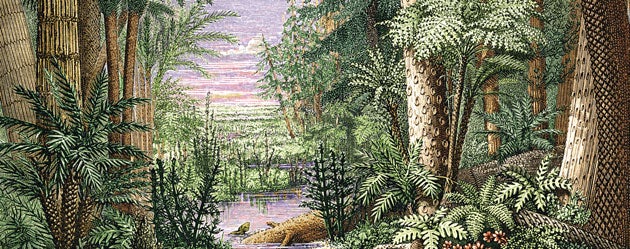Part two: the age of plants and insects
420 million years ago to 65.5 million years ago

How did life migrate from the seas on to land? What were the first land-pioneering species? The second part of our history of the world focuses on the moment when life-forms began to flourish beyond the oceans. It was, in every sense, a big moment, spanning a period of several hundred million years and marking the transformation of the Earth from inhospitable planet to something vaguely recognisable as the abundant, life-supporting world we know today.
The story pivots on ancestors of today's mosses, which learnt how to survive near the water's edge, gradually evolving over about 40 million years into tall, graceful trees that could colonise the land.
Some aspects of this metamorphosis are clear. Teamwork with other life-forms, such as fungi, turned craggy rocks into mineral-rich soil, smothering the Earth in a vital blanket of nutrients. The rapid rise of photosynthetic plants massively increased supplies of oxygen in the air which attracted other forms of life to emerge from the seas and try their luck with a life spent on land.
But other aspects of the story – such as the rise of the world's first flowering plants – remain puzzling. Fossils suggest they evolved more than 150 million years after the first trees, but what on Earth provoked the world's first bloom?
Such mysteries add to the fascination of our two-week account of the complete history of the planet, the remaining instalments of which appear with The Independent and the Independent on Sunday over the next 12 days and online.
Join our commenting forum
Join thought-provoking conversations, follow other Independent readers and see their replies
Comments